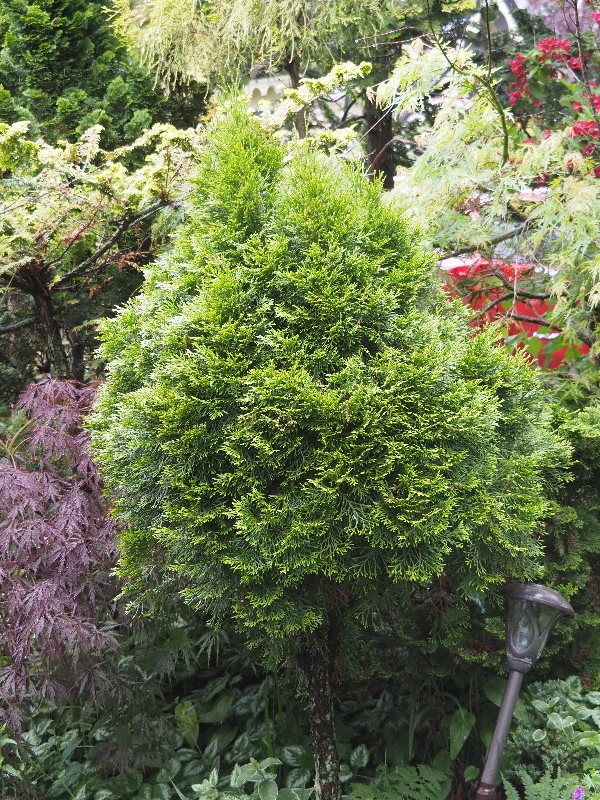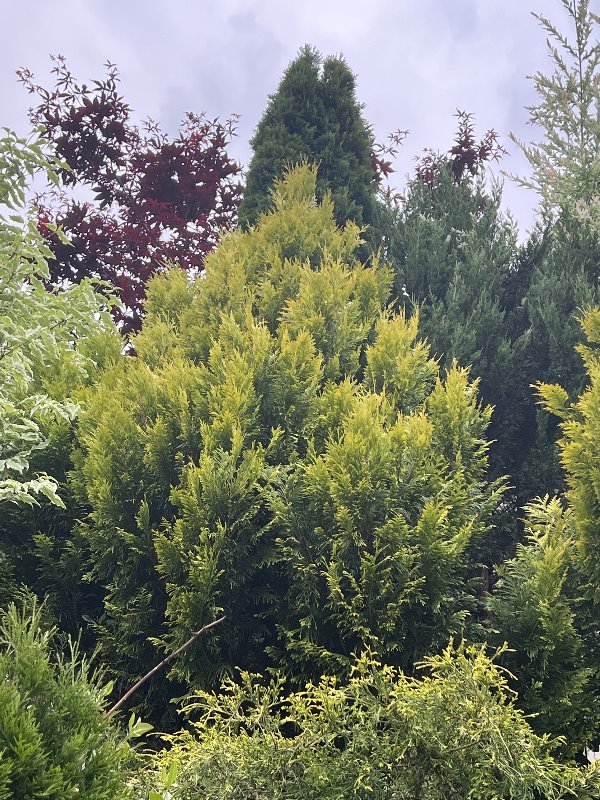Cypress is a separate genus of coniferous trees also in the cypress family (Cupressaceae). Cypress trees are evergreen and known for their distinctive appearance, typically with small, scale-like leaves or needle-like foliage.
There are various species of cypress trees found in different parts of the world. Some well-known examples include the
Italian cypress (Cupressus sempervirens),
Leyland cypress (× Cuprocyparis leylandii), and the
Bald cypress (Taxodium distichum).
Arbor Vitae = Thuja
The Arborvitae category (genus Thuja) consists of several cypress trees, commonly known as arborvitaes. These trees are part of the cypress family (Cupressaceae) and are native to North America and East Asia. Here are some of the cypress trees that belong to the Arbor Vitae category:
- American Arborvitae (Thuja occidentalis): Also known as Eastern Arborvitae or White Cedar, this species is native to eastern North America. It is a popular ornamental tree in landscaping due to its dense, evergreen foliage and ability to tolerate a variety of growing conditions.

Arbor Vitae -Emerald Green
Right Side of the Garden
Ashley Davidoff TheCommonVein.net Our Garden“Emerald Green” is a specific cultivar of Arborvitae (Thuja occidentalis). It is one of the most popular and widely planted cultivars in landscaping due to its attractive appearance and various practical uses.
Emerald Green Arborvitae is a compact, narrow, and dense evergreen shrub. Its foliage is dark green, soft, and scale-like, retaining its color throughout the year. The plant’s growth habit is columnar, making it an excellent choice for hedges, privacy screens, and windbreaks. It can also be used as an accent plant in gardens and landscapes.
One of the reasons for its popularity is its relatively low maintenance requirements. It is generally tolerant of a variety of soil conditions and is quite hardy once established. Regular watering, especially during dry periods, is essential for young plants, but once mature, they can handle periods of drought quite well.
Because of its size and shape, Emerald Green Arborvitae is often preferred over other varieties for creating dense barriers or borders in residential areas. It provides an elegant and neat appearance while offering practical benefits, such as noise reduction and privacy enhancement.
When considering planting Emerald Green Arborvitae, it’s essential to ensure it has enough space to grow vertically, as it can reach heights of around 10 to 15 feet (3 to 4.5 meters) or more at maturity, but its width remains relatively narrow, typically 3 to 4 feet (0.9 to 1.2 meters).
“Green Giant” is another specific cultivar of Arborvitae (Thuja plicata), commonly known as Western Red Cedar. It is a large evergreen tree with a pyramidal or conical shape. This cultivar is highly valued for its fast growth rate and its suitability for creating dense privacy screens and windbreaks.
Here are some key characteristics of the Green Giant Arborvitae:
- Size: Green Giant Arborvitae is a substantial evergreen tree that can reach impressive heights of 30 to 50 feet (9 to 15 meters) or more at maturity, with a spread of around 12 to 20 feet (3.6 to 6 meters). This rapid growth rate is one of its most significant advantages for those seeking a quick privacy solution in their landscape.
- Foliage: The foliage of the Green Giant Arborvitae is rich green, with scale-like leaves that have a soft texture. The foliage maintains its color throughout the year, providing an attractive, dense screen even during the winter months.
- Adaptability: This cultivar is known for its adaptability to various soil types and growing conditions. It can tolerate some drought once established, but regular watering is essential during its establishment period.
- Privacy Screen: Due to its size and dense growth habit, Green Giant Arborvitae is often used to create privacy screens along property lines, blocking out unwanted views and reducing noise from neighboring areas.
- Disease Resistance: Green Giant Arborvitae is generally resistant to many common diseases and pests that can affect other types of Arborvitae.
When using Green Giant Arborvitae for privacy screens, it’s essential to provide enough space for its mature size. Planting them with adequate spacing ensures they can grow and develop without becoming crowded and allows for proper air circulation.
“Forever Goldy” is not a specific species of Arborvitae (Thuja) but rather a cultivar or variety of the Eastern Arborvitae (Thuja occidentalis). It is a popular ornamental evergreen shrub with distinctive golden-yellow foliage, which sets it apart from the typical green color of most Arborvitae varieties.

Forever Goldy
Thuja Plicata
Left Garden Along the Deck
Ashley Davidoff TheCommonVein.net Trees in Our Garden
This may be a Thuja occidentalis ‘Filips Magic Moment’ because it is so big - The name “Forever Goldy” is a trade name or marketing name used to promote this particular cultivar. As with other Arborvitae, it is known for its compact growth and suitability for hedging or adding color contrast to landscaping.
- Western Red Cedar (Thuja plicata): Though commonly referred to as “cedar,” it is a member of the Arbor Vitae genus. Native to the Pacific Northwest of North America, it is one of the largest and longest-lived trees in the region. It has significant cultural and economic importance for indigenous peoples and has been used for various purposes, including building materials.
- Korean Arborvitae (Thuja koraiensis): This species is native to Korea and parts of eastern Russia. It is an attractive evergreen tree with a conical or narrow pyramidal shape. Like other arborvitaes, it is often used in landscaping as a hedge or screen due to its dense foliage.
- Japanese Arborvitae (Thuja standishii): Native to Japan, this species is a smaller-sized evergreen tree. It has a distinctive pyramid shape and can be a striking addition to gardens and landscapes.
- Sichuan Arborvitae (Thuja sutchuenensis): Found in China, this species is also a member of the Arbor Vitae genus. It is an evergreen tree with a conical shape and is valued for its ornamental qualities.
These cypress trees in the Arbor Vitae category are appreciated for their attractive appearance, dense foliage, and versatility in landscaping, making them popular choices in gardens, parks, and other green spaces.
Hinoki Cypresses
Hinoki Cypress (Chamaecyparis obtusa) is a species of cypress native to Japan. It is a slow-growing evergreen tree known for its elegant and graceful appearance. Hinoki Cypress has attractive, aromatic foliage that is scale-like and deep green in color.
Hinoki Cypress (Chamaecyparis obtusa) is a versatile and beautiful species of cypress native to Japan. There are several cultivars and varieties of Hinoki Cypress, each with its unique characteristics. Some popular types of Hinoki Cypress include:
- ‘Nana Gracilis’: This cultivar is known for its compact and slow-growing nature, making it an excellent choice for small gardens or containers. It forms a dense, rounded mound with bright green foliage.
- ‘Compacta’: As the name suggests, this variety is compact and has a dense, conical shape. Its foliage is dark green, and it grows relatively slowly.
- ‘Kosteri’: This cultivar has striking, lemon-yellow foliage that stands out in the landscape. It is a slow-growing, dwarf variety with a rounded form.
- ‘Spiralis’: This unique cultivar features twisted, spiral-like foliage, giving it a distinctive appearance. It has a narrow, upright growth habit and adds an interesting texture to the garden.
- ‘Verdoni’: Also known as ‘Verdoni Gold’ or ‘Verdoni Aurea,’ this variety has golden-yellow foliage that turns bronze in winter. It has a pyramidal shape and grows at a moderate rate.
- ‘Gracilis’: This is one of the most popular Hinoki Cypress cultivars, appreciated for its slender, conical shape and fine-textured foliage. It is a slow-growing tree with rich green foliage.
- ‘Tetragona Aurea’: This variety has bright golden-yellow foliage and a columnar growth habit. It stands out as an accent plant in the garden.
- ‘Nana Lutea’: This dwarf cultivar has small, yellow-golden foliage and a dense, mounding habit. It is an attractive choice for rock gardens and small landscapes.
